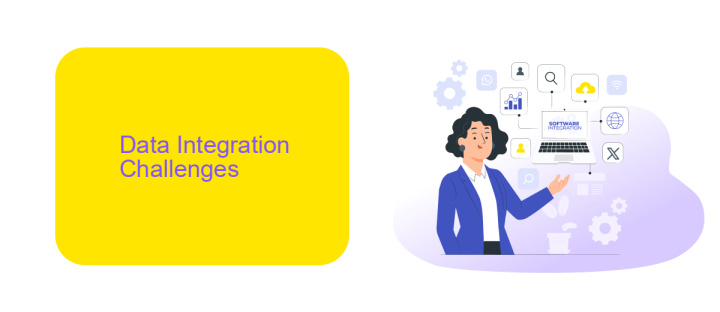Issues in Data Integration
Data integration is a critical process in modern data management, enabling organizations to combine data from diverse sources into a unified view. Despite its importance, the process is fraught with challenges such as data inconsistency, varying data formats, and semantic discrepancies. Addressing these issues is essential for accurate data analysis, informed decision-making, and achieving operational efficiency.
Introduction
Data integration is a critical process in the modern data-driven world, where combining data from different sources into a unified view is essential for comprehensive analysis and decision-making. However, this process is fraught with numerous challenges that can hinder its effectiveness and efficiency.
- Data quality and consistency issues
- Complexity in integrating diverse data formats
- Scalability and performance concerns
- Security and compliance risks
- High costs and resource requirements
To address these challenges, various tools and services have emerged to streamline the data integration process. One such service is ApiX-Drive, which offers an intuitive platform for automating data flows between multiple applications and systems. By leveraging solutions like ApiX-Drive, organizations can significantly reduce the complexities associated with data integration, ensuring a more seamless and efficient process.
Data Integration Challenges

Data integration poses several challenges, primarily due to the heterogeneity of data sources and formats. Organizations often deal with data coming from various databases, cloud services, and applications, each with its own schema and structure. This diversity makes it difficult to create a unified view of data, leading to inconsistencies and errors. Additionally, ensuring data quality and maintaining data integrity during the integration process are significant hurdles. Data may need to be cleaned, transformed, and standardized, which can be both time-consuming and resource-intensive.
Another challenge is the real-time integration of data, especially when dealing with large volumes of information. Traditional data integration tools may struggle to keep up with the speed and scale required. This is where services like ApiX-Drive can be invaluable. ApiX-Drive offers automated data integration solutions that can seamlessly connect various applications and services, facilitating real-time data synchronization. By using such platforms, organizations can reduce the complexity and manual effort involved in data integration, ensuring more accurate and timely data availability for decision-making.
Data Integration Techniques

Data integration techniques are essential for combining data from various sources into a unified view. These techniques ensure that data is consistent, accurate, and accessible across different platforms and systems. Several methods are commonly used to achieve effective data integration:
- ETL (Extract, Transform, Load): This process involves extracting data from different sources, transforming it into a suitable format, and loading it into a target database or data warehouse.
- Data Warehousing: A centralized repository where data from multiple sources is stored, enabling comprehensive analysis and reporting.
- API Integration: Utilizing APIs to connect different systems and enable data exchange in real-time. Services like ApiX-Drive facilitate seamless API integrations, allowing businesses to automate workflows and synchronize data efficiently.
- Data Virtualization: Creating a virtual layer that allows users to access and query data from multiple sources without needing to move or replicate the data.
- Data Federation: Combining data from different sources in real-time, presenting it as a single, unified view without physical consolidation.
Each technique has its advantages and is chosen based on the specific needs and complexity of the data integration project. By leveraging these techniques, organizations can ensure that their data is reliable, up-to-date, and readily available for decision-making processes.
Data Integration Tools and Technologies

Data integration tools and technologies are essential for combining data from disparate sources into a cohesive and usable format. These tools help organizations streamline their data workflows, ensuring that information is accurate, up-to-date, and easily accessible. Effective data integration can significantly enhance decision-making processes and operational efficiency.
Several tools and technologies are available to facilitate data integration. These solutions range from traditional ETL (Extract, Transform, Load) tools to more sophisticated cloud-based platforms that offer real-time data synchronization. The choice of tool often depends on the specific needs and infrastructure of an organization.
- ETL Tools: Talend, Informatica, Apache Nifi
- Cloud-Based Platforms: AWS Glue, Google Cloud Dataflow, Azure Data Factory
- API Integration Services: ApiX-Drive, Zapier, MuleSoft
ApiX-Drive, for example, provides a user-friendly interface for setting up integrations without the need for extensive coding knowledge. It allows businesses to connect various applications and automate data transfers, thereby reducing manual effort and minimizing errors. By leveraging such tools, organizations can achieve seamless data integration, leading to more efficient and effective data management.
Conclusion
In conclusion, data integration presents a myriad of challenges that organizations must address to ensure seamless data flow and accurate analytics. Issues such as data silos, inconsistent data formats, and security concerns are prevalent and require robust strategies to mitigate. Effective data integration is crucial for enhancing decision-making processes and operational efficiency, making it imperative for businesses to invest in reliable solutions.
Services like ApiX-Drive offer a comprehensive platform to streamline data integration efforts. By automating data transfers between various applications and systems, ApiX-Drive reduces the manual workload and minimizes the risk of errors. Leveraging such tools not only simplifies the integration process but also ensures data consistency and security. As the landscape of data continues to evolve, adopting advanced integration solutions will be essential for staying competitive and achieving sustainable growth.
FAQ
What are common challenges in data integration?
How can data quality be ensured during integration?
What is the role of ETL in data integration?
How can automation help in data integration?
What are data silos, and how can they be addressed?
Apix-Drive will help optimize business processes, save you from a lot of routine tasks and unnecessary costs for automation, attracting additional specialists. Try setting up a free test connection with ApiX-Drive and see for yourself. Now you have to think about where to invest the freed time and money!

